RHEGED | Brief History Of English Springers
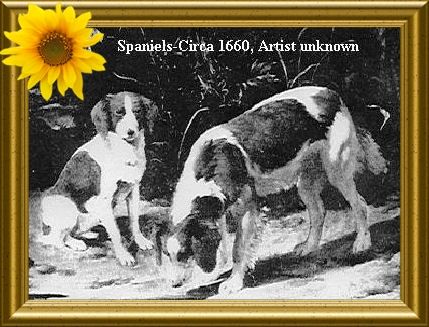
An old painting 'circa' 1660' depiction 'Springer Spaniels: Artist unknown
Of all the hunting Gundog breeds, the 'Spaniels' are the oldest. Although considered 'Gundogs', they have been around for centuries before the 'gun' was even invented! However, although record-keeping of modern times can tell us who is related to whom, it cannot tell us much about the ancient history of the dogs in our modern kennels.
In understanding the history of the 'English Springer Spaniel', first, it is necessary to understand the history of the 'Spaniel' & it is believed that the Roman Empire played a major role in bringing the 'Spaniels' to England, by way of the trade routes to the far east.
Although most dog books insist that the word 'Spaniel' is a corruption "espagnol", meaning "Spanish" or "Spain", there are many other authorities that believe the word may, in fact, be a corruption of "espanir", being French for "flatten out". The Italian name of the 'Piedmontese Spaniel' is the 'Spinone', a continental hunter that points & retrieves.
Whatever the true background of the 'Spaniel', way back in 1387 'Count Gaston de Foix' described a "Spaniel that worked by quartering in front of the hunter, & then flushed game either for the falcon or the hound". He also clearly described how "they retrieved ducks and geese from the water".
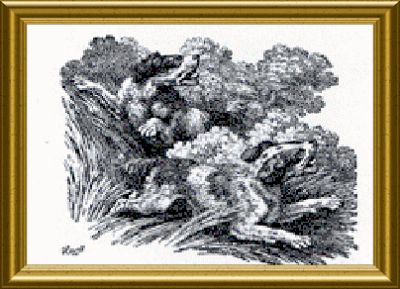
Ancient Spaniels: Artist unknown
'Aldrovandrus', in 1637, described "a Spaniel dog with floppy ears, the chest, belly, & feet white, picked out with black, the rest of the body black". 'Picking' here refers to the 'ticking' or 'freckles' found in the coats of both those ancient 'Spaniels' & those of today. 'Dr. Caius' describes the 'Spaniels' as "nearly all over white. If they have any spots, these are red, & scarce & big. There is also a red & black variety". Dr. Caius, when describing the 'Red, scarce Spaniels' is considered historically as referring to the 'Welsh Springer Spaniel' as opposed to the 'English Springer'.
In 1801, 'Sydenham Edwards' in the 'Cynographia Britannica' wrote that "the land spaniel may be divided into two kinds, the 'Springing', 'Hawking Spaniel' or 'Starter' (which is a synonym for the 'Welsh Springer Spaniel' ~ or as they are known in Wales ~ "Tarfgi"), & the 'Cocking', or 'Cocking Spaniel'". These types were not consistent, however, because back in 1621 'Gervase Markham' commented, "It is reasonable that people should cross 'Land Spaniels' & 'Water Spaniels', & the 'Mungrells' between these, & the 'Mungrells' of either with the 'Shallow-flewed Hound', the 'Tumbler', the 'Lurcher' & the small bastard 'Mastiff' ........ all of which are yet inferior to the true-bred 'Land Spaniel' ~ if one could still find one of those".
At any rate, by 1800, 3 general classifications were established: 'Cockers', used for 'Woodcock' weighed up to 25 lbs for larger dogs, whilst those of 17 ~ 18 inches tall & weighing 35 to 45 lbs were 'Field' or 'English Spaniels'. These included 'Springers', 'Field', 'Sussex', & the 'Clumber". The miniature, or toy spaniels fancied by King Charles & the Duke Norfolk, were called "Comforters".
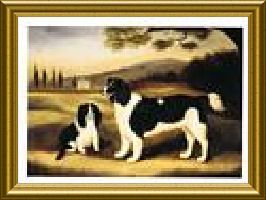
'Vero Shaw', in 1880, described "the last variety of the 'Springer' family which we will now treat is the 'Norfolk Spaniel' ... this dog is, when found pure, most usually a liver & white, the white spots being heavily freckled with liver ... a blaze of white up the forehead adds a great deal to his beauty". 'Idstone', in 1872 wrote: "Almost any liver coloured & white moderately large dog is called a 'Norfolk', more 'Norfolk Spaniels' are being used than any other ... most gamekeepers keep a liver & white one, & it goes by the name of the 'Norfolk Dog'.
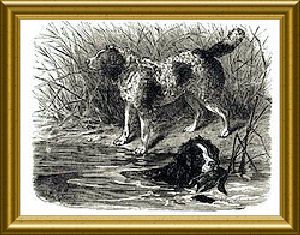
The now extinct 'Norfolk Spaniel'
'J. R. Walsh' (who wrote under the penname 'Stonehenge'), in 'The Dog of 1867', wrote: "The Norfolk Spaniel resembles a thick made 'English Setter' in shape & general proportions, but is a smaller size. This is a very useful breed, & is now generally spread throughout England, where, however, it is not kept very pure ............................". At this point in time, both 'Cocker Spaniels' & 'Springer Spaniels' were born in the same litters. The purpose of the breed was to serve as a hunting/flushing dog. The smaller 'Cockers' were used to hunt woodcock, while their larger littermates, the 'Springer Spaniels', would "spring" or "flush" the gamebird into the air where a trained falcon or hawk would bring it to the handler.
In January 1899, the 'Spaniel Club of England' & the 'Sporting Spaniel Society' held their trials together for the first time. Two years later, in 1902, a combination of the physical standard from the 'Spaniel Club of England' & the ability standard from the 'Sporting Spaniel Society' led to the 'English Springer Spaniel' breed being officially recognised by the 'Kennel Club' (UK).
The 'American Kennel Club' followed in 1910. In 1914, the first English Field Champion was crowned, 'FTC Rivington Sam' (he was also an English & International Champion), whose dam was a registered 'Cocker Spaniel', 'Rivington Riband'. 'Sam' is considered one of the foundation sires for modern field & show lines.
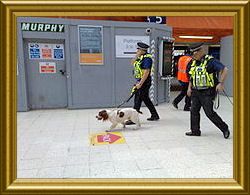
Springer Spaniels at work with the 'Metropolitan Police', London.
Springer Spaniels are commonly used as sniffer dogs for a variety of tasks & by a variety of nations.
Notable cases of explosive search dogs have included:
- "Buster", a Dickin Medal recipient, Royal Army Veterinary Corps arms & explosives search dog serving with the Duke of Wellington's Regiment in Iraq, for finding an extremist group's hidden arsenal of weapons and explosives.
- "Jake", aka 'Hubble Keck', a People's Dispensary for Sick Animals & Blue Cross Animal Hospital Medal recipient, a London Metropolitan Police explosives search dog. He was deployed at Tavistock Square, Russell Square & King's Cross following the 7th July 2005 London Bombings.
However the Springer's amazing nose is not limited to just explosives, they can also be used for much more precise work.
- "Murphy", a male Springer has been trained by 'HM Prison Service' in "HMP Norwich" to search for mobile phones. His nose is so precise that he can even tell the difference between the guard's phones & any illegal phones held by inmates.
Other varied uses for the Springer's nose can include sniffing out bumblebee nests, illegal immigrants, specific cancers & blood. Springers are used as drug dogs by agencies in a variety of nations including Sweden, Finland, Great Britain, Isle of Man, Canada, USA & Qatar to name but a few countries to enlist the wonderful 'Springer Spaniel' in many practical ways.
All content copyright © 2015
